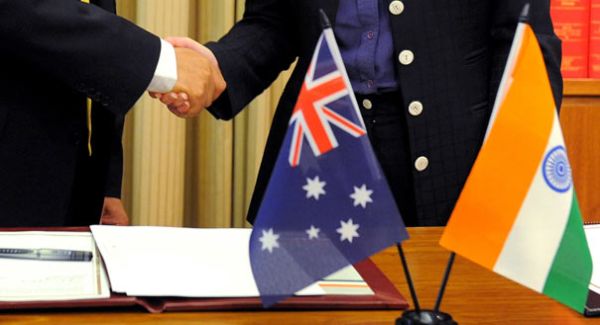Sydney, (IANS) : Despite a flurry of media reports suggesting a serious rethink, Australia continues to actively pursue the finalisation of a Free Trade Agreement (FTA) with India. There seem to be two sticking points: India’s high tariff rates and whether Australia would ever export uranium to India.
With some government officials recently expressing frustration over the slow pace of the negotiations, doubts are being raised whether Australia was serious about inking the deal, also known as the Comprehensive Economic Cooperation Agreement (CECA), with India.
The pace of the negotiations may slow down in the coming months but, it seems, the upswing in bilateral ties would continue under Australia’s incumbent Liberal government.
“Bilateral ties have deepened significantly since Prime Minister (Narendra) Modi’s 2014 visit. The government is pursuing an ambitious bilateral agenda with India and Prime Minister Turnbull met Prime Minister Modi on November 15, 2015, and September 4, 2016, during G20 Summits,” Australian Minister for Trade, Tourism and Investment Steven Ciobo said in a communication.
The two-way goods and services trade between Australia and India totalled A$18 billion (Rs 910 billion) in 2014-15. Of this, Australia’s exports to India was at A$12.7 billion and the imports from India were A$5.3 billion.
Turnbull’s government continues to view the rising South Asian economic powerhouse with intense interest.
“India’s economy offers significant opportunities — our economies are highly complementary. Soon after Prime Minister Modi’s visit, the Australia Business Week in India (ABWI) exposed a delegation of 450 business leaders to the trade and investment opportunities presented by India,” Ciobo noted.
It is not that India is playing the role of a recalcitrant partner in the trade pact. While former Trade Minister Andrew Robb made no less than four visits to India last year to escalate the negotiations, a number of Indian ministerial delegations have also touched down in Australia to strengthen bilateral ties.
“A more recent visit to Australia by Finance Minister (Arun) Jaitley in March/April 2016, with two business delegations, highlighted the potential for two-way investment, which has been on an upward trajectory since Prime Minister Modi’s visit,” Ciobo pointed out.
The defence of Australia’s stance on the FTA was echoed by Sheba Nandkeolyar, National Chair of the Australia India Business Council.
“Since Prime Minister Modi’s visit to Australia, there have been innumerable visits made by (then) Minister Andrew Robb and his team to India,” Nandkeolyar told IANS.
“India traditionally has tariffs which are very high and complicated. To expect India to suddenly abolish or bring down everything is not a win situation for India either,” she opined.
While there are conflicting reports about the progress and fate of the FTA, some commentators have also been raising doubts whether Australia would ever export uranium to India. Supply of the crucial fuel required for the mushrooming Indian nuclear power stations has been a contentious issue ever since the then Australian Prime Minister John Howard expressed his government’s willingness to lift the uranium export ban in 2007.
“The governments of Australia and India opened the door to the supply of Australian uranium to India in late 2015 by bringing a bilateral nuclear cooperation agreement into force,” Ciobo pointed out.
“The Australian government understands that commercial negotiations on supply contracts are advancing well, and looks forward to seeing exports commence soon,” he added.
“The Australia-India nuclear cooperation agreement was negotiated and brought into force in the period 2013-2015,” Ciobo said.
Even though Modi and his predecessor Manmohan Singh have done significant work to improve bilateral ties, there is a general perception that New Delhi can do more to keep the trajectory moving northwards.
The ongoing Festival of India in Australia is cited as one example of the Modi government’s willingness to engage with Australia.
India’s low position on the World Bank’s Ease of Doing Business index is often cited as one reason why the bilateral ties are not moving at the same pace as with China (Indian ranking 130 vs China 84) which is Australia’s largest trading partner.
“More visits by senior business leaders, more bilateral cultural events and festivals like Confluence,” Nandkeolyar replied when asked what India can do to improve bilateral ties.
She said there is a need to debunk the perception that India is a hard place to do business and highlight ground-breaking measures such as the introduction of the Goods and Services Tax, “which has international business ramifications”.
(Rekha Bhattacharjee can be contacted at vijay@hotkey.net.au)






0 Comments